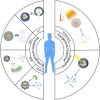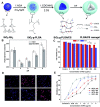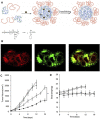Tumor Microenvironment-Responsive Polypeptide Nanogels for Controlled Antitumor Drug Delivery
- PMID: 34776965
- PMCID: PMC8578677
- DOI: 10.3389/fphar.2021.748102
Tumor Microenvironment-Responsive Polypeptide Nanogels for Controlled Antitumor Drug Delivery
Abstract
Tumor microenvironment-responsive polypeptide nanogels belong to a biomaterial with excellent biocompatibility, easily adjustable performance, biodegradability, and non-toxic properties. They are developed for selective delivery of antitumor drugs into target organs to promote tumor cell uptake, which has become an effective measure of tumor treatment. Endogenous (such as reduction, reactive oxygen species, pH, and enzyme) and exogenous (such as light and temperature) responsive nanogels can release drugs in response to tumor tissues or cells to improve drug distribution and reduce drug side effects. This article systematically introduces the research progress in tumor microenvironment-responsive polypeptide nanogels to deliver antitumor drugs and provides a reference for the development of antitumor nanoformulations.
Keywords: copolymer; drug delivery; nanogels; nanoparticle; polypeptide; stimulus-responsive.
Copyright © 2021 Liu, Chen, Shi, Zhao and Ma.
Conflict of interest statement
The authors declare that the research was conducted in the absence of any commercial or financial relationships that could be construed as a potential conflict of interest.
Figures











Similar articles
-
Intelligent responsive nanogels: New Horizons in cancer therapy.Int J Pharm. 2025 Jan 25;669:125050. doi: 10.1016/j.ijpharm.2024.125050. Epub 2024 Dec 5. Int J Pharm. 2025. PMID: 39645062 Review.
-
Stimulus-responsive polymeric nanogels as smart drug delivery systems.Acta Biomater. 2019 Jul 1;92:1-18. doi: 10.1016/j.actbio.2019.05.018. Epub 2019 May 13. Acta Biomater. 2019. PMID: 31096042 Free PMC article. Review.
-
Tumor microenvironment responsive nanogels as a smart triggered release platform for enhanced intracellular delivery of doxorubicin.J Biomater Sci Polym Ed. 2021 Feb;32(3):385-404. doi: 10.1080/09205063.2020.1837504. Epub 2020 Oct 28. J Biomater Sci Polym Ed. 2021. PMID: 33054642
-
Polypeptide Nanogels With Different Functional Cores Promote Chemotherapy of Lung Carcinoma.Front Pharmacol. 2019 Feb 4;10:37. doi: 10.3389/fphar.2019.00037. eCollection 2019. Front Pharmacol. 2019. PMID: 30778298 Free PMC article.
-
pH-Sensitive nanogels for drug delivery in cancer therapy.Biomater Sci. 2021 Feb 9;9(3):574-589. doi: 10.1039/d0bm01729a. Biomater Sci. 2021. PMID: 33306076 Review.
Cited by
-
Polypeptide-Based Systems: From Synthesis to Application in Drug Delivery.Pharmaceutics. 2023 Nov 20;15(11):2641. doi: 10.3390/pharmaceutics15112641. Pharmaceutics. 2023. PMID: 38004619 Free PMC article. Review.
-
Recent Advances in Zein-Based Nanocarriers for Precise Cancer Therapy.Pharmaceutics. 2023 Jun 26;15(7):1820. doi: 10.3390/pharmaceutics15071820. Pharmaceutics. 2023. PMID: 37514006 Free PMC article. Review.
-
Review projecting shikonin as a therapeutic candidate in female carcinomas: a preclinical perspective.Front Pharmacol. 2025 Jul 4;16:1627124. doi: 10.3389/fphar.2025.1627124. eCollection 2025. Front Pharmacol. 2025. PMID: 40689201 Free PMC article. Review.
-
Heme oxygenase-1 leads to cisplatin resistance in nasopharyngeal carcinoma by reducing oxidative stress and ferroptosis.Cancer Cell Int. 2025 Aug 11;25(1):302. doi: 10.1186/s12935-025-03908-6. Cancer Cell Int. 2025. PMID: 40790738 Free PMC article.
-
Biomedicine Innovations and Its Nanohydrogel Classifications.Pharmaceutics. 2022 Dec 18;14(12):2839. doi: 10.3390/pharmaceutics14122839. Pharmaceutics. 2022. PMID: 36559335 Free PMC article. Review.
References
-
- Abdullah-Al-Nahain N., Nam J. A., Mok H., Lee Y.-k., Park S. Y. (2013). Dual-responsive Crosslinked Pluronic Micelles as a Carrier to Deliver Anticancer Drug Taxol. Macromol. Res. 21 (1), 92–99. 10.1007/s13233-013-1011-z - DOI
-
- Arroyo-Crespo J. J., Armiñán A., Charbonnier D., Balzano-Nogueira L., Huertas-López F., Martí C., et al. (2018). Tumor Microenvironment-Targeted Poly-L-Glutamic Acid-Based Combination Conjugate for Enhanced Triple Negative Breast Cancer Treatment. Biomaterials 186, 8–21. 10.1016/j.biomaterials.2018.09.023 - DOI - PubMed
Publication types
LinkOut - more resources
Full Text Sources

